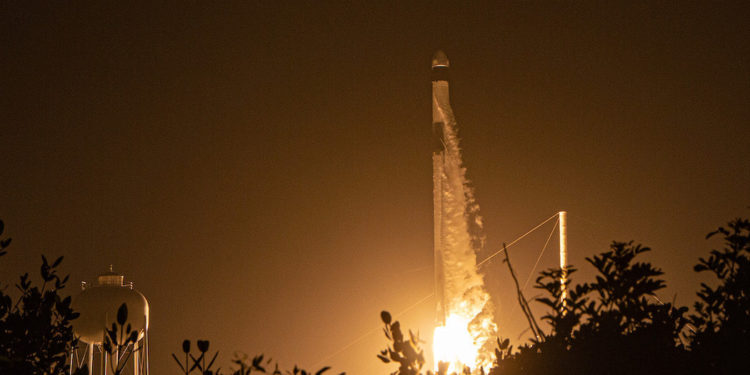
SpaceX launched a Dragon cargo capsule from Florida on a thundering predawn ascent into orbit early Sunday aboard a Falcon 9 rocket, kicking off the company’s 23rd commercial resupply flight to the International Space Station.
The two-stage Falcon 9 launcher, standing 215 feet (65 meters) tall, roared to life and fired away from pad 39A at NASA’s Kennedy Space Center at 3:14:49 a.m. EDT (0714:49 GMT), an instantaneous launch opportunity set by the moment Earth’s rotation brought the spaceport under the space station’s orbital plane.
A launch attempt Saturday morning was scrubbed due to stormy weather at the space center.
Nine Merlin 1D main engines, each consuming kerosene and liquid oxygen propellants, powered the rocket northeast from Florida’s Space Coast with 1.7 million pounds of thrust.
After climbing into a moonlit sky, the Falcon 9’s first stage shut down and separated, allowing the rocket’s single engine second stage to finish the job of placing the Cargo Dragon capsule into orbit.
The 15-story-tall first stage, meanwhile, reignited three of its engines near the edge of space to begin propulsive maneuvers to guide itself toward SpaceX’s drone ship “A Shortfall Of Gravitas” positioned some 180 miles, or about 300 kilometers, northeast of Cape Canaveral.
The initial maneuver, called a “boost back burn,” slowed the stage’s downrange velocity, then an entry burn a few minutes later made another adjustment to its trajectory back into the atmosphere. A final booster burn using the rocket’s center engine slowed the vehicle for a touchdown on the deck of the drone ship.
Falcon 9 has landed on SpaceX’s drone ship “A Shortfall Of Gravitas” in the Atlantic Ocean.
This is the first rocket landing on SpaceX’s newest drone ship, and the 90th recovery of a Falcon booster.https://t.co/25YudXtx6y pic.twitter.com/et2bIiyd4i
— Spaceflight Now (@SpaceflightNow) August 29, 2021
The booster completed its fourth trip to space, following missions in November 2020 and in April with astronaut-carrying Crew Dragon capsules. Its third flight, on June 6, carried a SiriusXM radio broadcasting satellite into space.
While the Falcon 9’s first stage made a routine, but spectacular, landing downrange, the upper stage finished the task of placing the Cargo Dragon spacecraft into orbit.
The capsule deployed from the upper stage nearly 12 minutes after liftoff and opened its nose cone a few minutes later, revealing the ship’s docking mechanism for approach to the space station.
The launch Sunday marked the 21st launch of a SpaceX Falcon 9 rocket this year, but the first in nearly two months. The gap between launches came as SpaceX paused missions hauling the company’s Starlink internet satellites into orbit. The Starlink missions are scheduled to resume in September, according to Gwynne Shotwell, SpaceX’s president and chief operating officer.
With a successful launch in the books, a series of firings using the Dragon capsule’s Draco thrusters will fine-tune the spacecraft’s course to the space station, culminating in an automated, laser-guided docking to the complex at 11 a.m. EDT (1500 GMT) Monday.
The Dragon cargo ship will deliver 4,866 pounds (2,207 kilograms) of supplies and experiments. The mission marks SpaceX’s 23rd resupply flight to the space station since 2012 under contract to NASA.
It will be the third flight of an upgraded variant of SpaceX’s Dragon cargo ship based the company’s human-rated capsule. It’s the second mission for this particular spacecraft.

Besides fresh food, including ice cream and other treats, the Cargo Dragon is set to deliver an array of technology demonstration, materials science, and biomedical experiments to the space station.
They include a small robotic arm from GITAI Japan Inc., a Japanese company, to demonstrate in-space tasks that could lead to development of future robots to assist astronauts on long-duration space missions. The arm will run through its demonstrations, including switch and cable operations and in-space assembly experiments, inside the commercial Bishop airlock owned Nanoracks.
Some of the tasks will be autonomous, while others will be tele-operated from Nanoracks’ facility in Houston, according to GITAI.
“This technology demonstration is to show the world that the capabilities necessary for automation in space are finally available,” said Toyotaka Kozuki, GITAI Japan’s chief technology officer, in a statement. “It provides an inexpensive and safer source of labor in space, opening the door to the true commercialization of space.”
The mission also carries an experiment hosting package called the Faraday Research Facility. Developed by a Houston company named ProXops, the facility will be inserted by astronauts into one of the space station’s science racks.
On this flight, the facility carries an experiment from Houston Methodist Research Institute to test an implantable, remote-controlled drug delivery system. Scientists say the experiment could offer an alternative to bulky infusion pumps to help treat chronic conditions in patients on Earth.
NASA says the facility also hosts two educational experiments to be performed on the space station, including one with participation from a Girl Scout troop on the ground.
There are also multiple CubeSats stowed inside the Cargo Dragon’s pressurized compartment. They will be robotically deployed outside the space station in the coming weeks and months.
The Cargo Dragon capsule is expected to remain docked to the space station for more than a month. At the end of its mission, the spacecraft will undock and return to Earth with several tons of cargo for a parachute-assisted splashdown off the coast of Florida.
Email the author.
<em>Follow Stephen Clark on Twitter: @StephenClark1.
